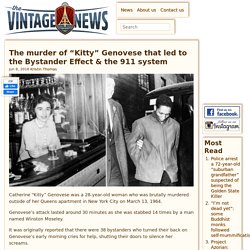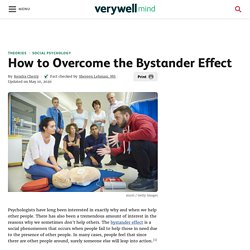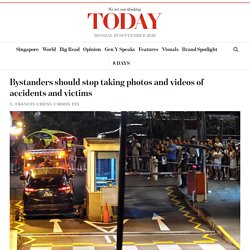

Many psychological experts would mention about the bystander effect. So what exactly is bystander effect?
Bystander effect, in simple terms, is an effect whereby someone is less likely to help a person in distress when there is a large number of bystanders present during the situation or incident.
The bystander effect may seem like a tough psychological barrier to overcome for most people. However, there are many various ways to overcome it.
Bystander Effect - Definition, Examples and Experiment. Bystander Effect Definition The bystander effect, also called bystander apathy, is a term in psychology that refers to the tendency of people to take no action in an emergency situation when there are others present. This phenomenon is highly studied in the field of sociology. What Is the Bystander Effect? If you witnessed an emergency happening right before your eyes, you would certainly take some sort of action to help the person in trouble, right?

While we might all like to believe that this is true, psychologists suggest that whether or not you intervene might depend upon the number of other witnesses present. Bystander Effect: Diffusion of Responsibility. Diffusion of Responsibility - Definition and Examples - One Mind Therapy. Research on the Diffusion of Responsibility Many studies have looked at the bystander effect. John Darley and Bibb Latané were two of the first psychologists to develop a diffusion of responsibility experiment. Following the murder of Kitty Genovese in the late 1960’s, Latané and Darley conducted studies investigating the effect.
In their first and most well-known study, they looked at the relationship between group size and reporting danger. Study participants were asked to fill out a questionnaire in a room that was slowly filling with smoke. An interesting finding is that the phenomenon impacts groups of only three people. Latané and Darley created a model of helping to describe the process through which individuals go before taking action. Noticing A bystander must first notice that an event is occurring. Utilizing the Diffusion of Responsibility Understanding this phenomenon can help us to take action as individuals and as a greater society. Explaining Social Inaction. The murder of "Kitty" Genovese that led to the Bystander Effect & the 911 system.
Catherine “Kitty” Genovese was a 28-year-old woman who was brutally murdered outside of her Queens apartment in New York City on March 13, 1964.

Genovese’s attack lasted around 30 minutes as she was stabbed 14 times by a man named Winston Moseley. It was originally reported that there were 38 bystanders who turned their back on Genovese’s early morning cries for help, shutting their doors to silence her screams. Although that judgment was later proven to be inaccurate, the murder was considered the driving force behind our emergency 911 system today and the discovery of the term that so many psychologists are still researching: “The Bystander Effect.”
It was around 3 o’clock in the morning when Genovese arrived home from managing a local bar where she worked. Kitty Genovese She parked her car and started walking towards her apartment building, when she noticed a man standing at the corner end of the parking lot. A New Look at the Killing of Kitty Genovese: The Science of False Confessions – Association for Psychological Science – APS. On March 13, 1964 a woman named Catherine “Kitty” Genovese was murdered outside of her apartment in Queens, New York.

Over the course of a brutal attack lasting over 30 minutes, Genovese was stabbed at least 14 times. How to Overcome the Bystander Effect. Psychologists have long been interested in exactly why and when we help other people.

There has also been a tremendous amount of interest in the reasons why we sometimes don't help others. The bystander effect is a social phenomenon that occurs when people fail to help those in need due to the presence of other people. How To Counteract The Bystander Effect - University of Pittsburgh Student EMS. Counteracting The Bystander Effect It is a beautiful spring day in Oakland.

There are just a few weeks left until summer break and everyone is ready to go home. You are in Cathy studying and you see that the person a few tables over seems to be passed out. You notice they haven't moved in hours. Hundreds of people have walked by and seem to take notice but no one has done anything. Return To PITTect Your Friends HomePage Create your own unique website with customizable templates.
Get Started. TODAYonline. I refer to the news reports of the fatal traffic accident on Sunday (Dec 29) at Lucky Plaza.

I applaud the Good Samaritans who unselfishly helped to lift up the car, pulled the victims out and attended to them. These are acts of true heroism. They encourage us to lend help to accident victims when needed and show that there are still compassionate people who don’t respond to accidents by whipping out their phones first to take videos and photos to circulate to their friends. In Sunday’s incident, one of the first things a bystander could do was to rush to the nearby Mount Elizabeth Hospital Accident and Emergency Department to seek help, as it would have the necessary medical equipment and trauma specialists on duty. This was crucial as the Singapore Civil Defence Force ambulances would take some time to arrive and the accident victims needed immediate medical attention and first aid.